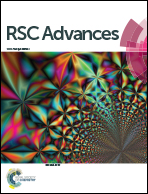Amorphous nanosized Al–Ti–Mn trimetal hydrous oxides: synthesis, characterization and enhanced performance in arsenic removal†
Abstract
Arsenite (As(III)) is more toxic and more difficult to remove from water than arsenate (As(V)). There is no simple treatment for direct efficient removal of As(III), and thus pre-oxidation of As(III) to As(V) is always required to achieve acceptable removal rates. However, this leads to a complicated operation, which is not cost-effective. To overcome these disadvantages, we have developed a novel nanosized Al–Ti–Mn trimetal hydrous oxide (ATM) adsorbent material combining the oxidation properties of manganese dioxide and the high capacity of aluminium hydrous oxide and titanium hydrous oxide to adsorb As(V). This was done by applying a method based on simultaneous oxidation and precipitation. The adsorbent was characterized by BET surface area measurement, as well as XRD, TEM, XPS, FTIR and TGA techniques. The characterization provided evidence that the new adsorbent was amorphous, had a relatively high surface area (71 m2 g−1) and consisted of aggregates of many nanosized particles. Laboratory experiments were carried out to investigate the adsorption kinetics, the adsorption capacity of the adsorbent and the effect of the pH of the solution on the overall arsenic removal. The results indicated that the ATM adsorbent performed excellently in removing both As(III) and As(V) from water. The maximum adsorption capacities for As(III) and As(V) calculated from the Langmuir model are 202.7 and 146.7 mg g−1 (pH 7.0), and 193.3 and 158.6 mg g−1 (pH 5.0), respectively. These values exceed significantly those reported in the literature for other nano-adsorbents. Furthermore, the result of XPS analysis of the adsorbent before and after interaction with As(III) confirmed the oxidation/adsorption mechanism for As(III) uptake by ATM. The comparison of –OH density (OH per g) in fresh ATM and ATM after adsorption of As(III) and As(V) shows that the number of –OH groups on the adsorbent surface was the key factor affecting its adsorption capacity. The amorphous nanosized Al–Ti–Mn trimetal hydrous oxide is thus a promising adsorbent for both As(III) and As(V) removal because of its excellent performance and simple low-cost synthesis process.


 Please wait while we load your content...
Please wait while we load your content...